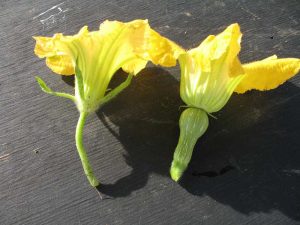Why hand pollinate, you may ask? The first reason is to get a greater yield. Bees usually do the deed, but not necessarily consistently, and not in all weather conditions. Also, bee population may be low in your area. The second reason is for seed saving, if you want to save the seeds from one of the squash fruits that you harvest this year to sow for next spring, the only way to guarantee that those squash will be the same variety as the mother plant, will be to prevent cross pollination from a different squash plant.
Careful hand pollination will prevent cross pollination. First, you will need to know the difference between the male and female flowers which grow together on the same plant. The Male flowers have straight thin stems, while the female flower has a thicker stem which has a swelled area just under the blossom end. This is the female ovary which will become the fruit (squash) after pollination. Don’t fret if only male flowers appear when blossoming begins. The females will arrive in time, and this is where you need to be observant. You will want to fertilize the female flower shortly after it has fully opened, as it only blooms for a day. Morning is usually best.
There are two common ways to hand pollinate. One is to use a soft paint brush, the type you can purchase at an art supply store. Gently brush the male stamen, which is the tip of the anther in the middle of the flower. You should see the yellow dust on the end of the bristles. Now go to the female flower and gently “paint” or dust the stigma at the top of the pistil which is in the middle of her flower. Method #2 is to pick the male flower, pull the petals back and brush the female stigma with the fully exposed male stamen. You have now pollinated your squash flower! Repeat this process for every female blossom.
If you want to save the seeds, you can protect the flowers from being cross pollinated by bagging (a piece of muslin, or some other breathable material) the female flower before it opens. Secure the cloth around the blossom end snuggly, not too tightly. You don’t need to do this to every female flower. Remove the bag just to hand pollinate and then quickly replace the bag after the hand pollination is complete. Once the blossom dies you can remove the bag, but before you do, tie a colored ribbon around the squash stems of the ones you bagged so that you know that these were not cross pollinated.
You can follow this method for other fruits of the cucurbit family, which includes melons, cucumbers and pumpkins.
Sources: Editors update, Vegetarian Times, May 9, 2019
Reader contribution, by Benedict Van Heems, Mother Earth News, July 17, 2019
Wendy Kubow is a University of California Cooperative Extension Master Gardener of Calaveras County.
UCCE Master Gardeners of Tuolumne and Calaveras Counties can answer home gardening questions. Call 209-533-5912 or to fill out our easy-to-use problem questionnaire here. Check out our website here, You can also find us on Facebook.

